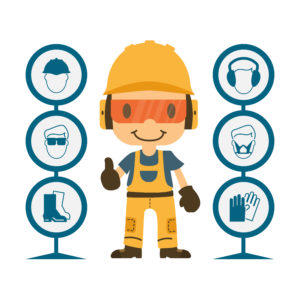Based on the most recent official estimates, the annual cost of work-related injuries and illnesses is a staggering £14.9bn . With such a lot at stake, there is no doubt that there is an ever-present need to do everything possible to make workplaces even safer. In our modern age, there is an emerging range of technology that adds to the established basic equipment designed to keep workers safe in their jobs. But what are these innovations, and can they play a role in reducing the number of workplace accidents?
PPE and the law
The acronym PPE stands for ‘personal protective equipment’ and includes any accessory worn by workers to make them safer. Such items include: 
• Helmets
• Goggles
• Protective clothing
• Ear protection
• Respirators
• Skin protection
Under the Personal Protective Equipment at Work Regulations 1992, section 4, it is made clear that all employers must provide PPE to employees who during the course of performing their work duties may be exposed to health or safety risks. The regulation guidance states that PPE should be provided where there are no other means to adequately control the risk, and training must be provided for its proper use. It is also made clear that no charge can be levied on the employee for the provision of the equipment .
PPE may be used to protect employees from such risks as contaminated air, extreme temperature, corrosive materials or liquids, falling objects, splinters, or sparks.
PPE in a modern world
Most people will be familiar with the traditional PPE equipment as listed above but given that any device worn for safety constitutes PPE, the possibilities for new solutions are almost limitless – with some creative thinking; here are some examples:
Lone worker safety
Ensuring the safety of employees while working alone can be problematic, as the range of factors outside of the employer’s control is considerable. New solutions are emerging which enable workers to raise an alert if they need assistance. The ‘URSOSButton’ product has recently been rolled out by Nottingham City Homes to its team of community-based workers. The solution is a mobile phone app that reliably allows someone in trouble to press an ‘SOS’ button (in a manner that is unencumbered by screen locks and passwords). When the button is pressed, a central office then receives the GPS coordinates of the person, and a phone call is made with an open mic, allowing the staff to listen in on what is happening; they can then decide on the best course of action . Such technology means that the overhead is reduced on the employer as the monitoring is handled by a centralised team. The benefit being that staff are kept safe without the need to rely on managers and colleagues to respond to a problem – saving time and money.
Culturally inclusive PPE
Ensuring compliance with the use of PPE in the workplace is important, however there are some barriers to this. Traditional PPE clothing, for example, does not take into account the gender or cultural background of the worker, and this risks alienating a large percentage of the workforce for whom PPE is not designed to meet their needs. For example, some Muslim women who prefer to wear a Burka or Hijab, feel uncomfortable wearing traditional PPE clothing. A group of innovators, funded by the Tideway Innovation Forum, have designed a new range of culturally appropriate PPE clothing, which is also fully in accordance with the regulations for visibility and reflectivity . This is a simple example of innovation which will increase adoption of good safety practice by including the wider needs of workers, in a manner that is not highly technological.
The rise of the wearable safety device
Getting back to technology for the third innovation in this article, construction sites are now embracing new wearable technology. A simple device developed by Site Zone is designed to ensure that workers do not breach the ‘safety bubble’ around working construction machinery. A transponder, using RFID technology (similar to your contactless payment card), is worn by personnel on the site. If they enter the ‘bubble’, the machine operator is instantly informed of the risk, and can then react accordingly. Also, there is an alarm which can alert the person on the ground who is at risk so that they can move to safety. Such innovation is leveraging already mainstream technology in a simple but effective way to make construction sites safer. Given that construction has the second highest rate of workplace injuries, this is a welcome use of modern PPE technology.
The future looks extremely bright for many more ground-breaking ideas that will make further inroads into accident rates in UK workplaces. However, for all the possibilities that these will bring, there remains no substitute for thorough risk assessment and management by employers, and vigilance and adherence to health and safety guidelines by employees. In other words, when it comes to health and safety in the workplace, there is simply no room for complacency.
At Russell Worth Solicitors we specialise in personal injury claims. If you have suffered a workplace injury and would like a free claim assessment, please call us now on 0800 028 2060 or complete our Online Claim Assessment.

